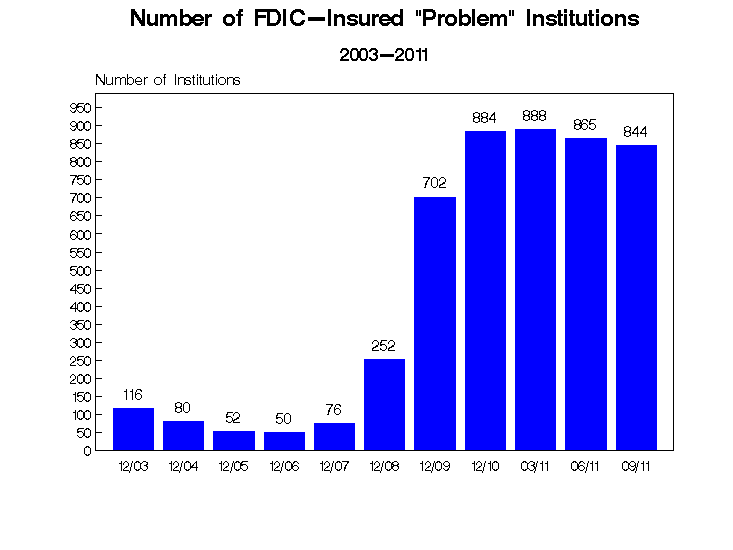 I know that the financial information presented in this article may be seen as just another piece of bad news to add the list. However, this may be the one article that explains the true gravity of our country’s financial condition and how the impending collapse of the European Union will impact our US banks. The executive summary from the OCC’s Quarterly Report on Bank Trading and Derivatives Activities Third Quarter 2011 paints a doomsday scenario for US Banks: The notional amount of derivatives held by insured U.S. commercial banks is $248 trillion. This is why there are currently 844 banks on the FDIC troubled bank list.
I know that the financial information presented in this article may be seen as just another piece of bad news to add the list. However, this may be the one article that explains the true gravity of our country’s financial condition and how the impending collapse of the European Union will impact our US banks. The executive summary from the OCC’s Quarterly Report on Bank Trading and Derivatives Activities Third Quarter 2011 paints a doomsday scenario for US Banks: The notional amount of derivatives held by insured U.S. commercial banks is $248 trillion. This is why there are currently 844 banks on the FDIC troubled bank list.
In general, banks included on the Problem Bank List have serious deficiencies with their finances, operations, or management that threaten their continued solvency. Once a bank is included on the list, they are subject to closer regulatory scrutiny. They can also expect to receive instructions from regulators about what steps must be taken to rebuild their financial strength.
From the FDIC:
Problem Banks – The FDIC creates reports on problem or troubled banks in the aggregate. We do not make the details of this list publicly available.
So how many banks are on the unofficial troubled bank list that the FDIC will not divulge?
The number of banks on the confidential FDIC Problem Bank List is at a 20 year high. As of September 30, 2011, there were 844 institutions on the Problem Bank List, the largest number since 1992 when the total was 1,066.
Since the beginning of the financial crisis in 2008, a total of 417 banks have failed nationwide, yet the number of problem banks remains stubbornly high. Considering the large number of banking failures over the past four years, the number of problem banks should have declined as failed banks fell off the Problem Bank List.

The Federal Deposit Insurance Corporation (FDIC) is now virtually wiped out:
Interesting Facts On The Banking Failures of 2011
1. The total losses to the FDIC Deposit Insurance Fund for 2011 bank failures was approximately $7.2 billion. Losses on bank failures since 2008 have totaled $86.3 billion, virtually wiping out the deposit insurance fund which currently insures $6.8 trillion.
If US banks take a Grecian Formula haircut of 65% on this exposure, the cost to the US taxpayers is $161.2 trillion. Even a 10% cut would be $24 trillion. What are these derivatives? These are the same derivatives that Jon Corzine bet on which bankrupted MF Global. Why do you have any money in any bank? This is the true state of the union that that Ben Bernanke and Tim Geithner are hiding.
David DeGerolamo
Related Articles:
ON BANKS REFUSING CASH WITHDRAWALS – Ann Barnhardt
Why Do You Have Still Have Money in a Bank?
How Much Longer Will the Dollar Be the World’s Reserve Currency?
Borrowing Prosperity From the Future
OCC’s Quarterly Report on Bank Trading and Derivatives Activities Third Quarter 2011
Executive Summary
- Insured U.S. commercial banks reported trading revenues of $13.1 billion in the third quarter, 78% higher than in the second quarter, and 214% higher than $4.2 billion in the third quarter of 2010. Revenues in the third quarter were a record, but overstate actual trading performance due to the inclusion of a significant amount of revenues that were unrelated to core trading activities.
- Trading risk exposure, as measured by Value-at-Risk (VaR), decreased in the third quarter as dealers actively reduced risk in the face of increasing global financial risks. Aggregate average VaR at the 5 largest trading companies declined 6.1% from the second quarter to $673 million. VaR in the third quarter 2011 was 8.8% lower than a year ago.
- Credit exposure from derivatives increased sharply in the third quarter. Net current credit exposure increased 39%, or $141 billion, to $504 billion, due to declining interest rates.
- The notional amount of derivatives held by insured U.S. commercial banks decreased $1.4 trillion, or 0.6%, from the second quarter of 2011 to $248 trillion. Notional derivatives are 5.7% higher than at the same time last year.
- Derivative contracts remain concentrated in interest rate products, which comprise 82% of total derivative notional amounts.Credit derivatives, which represent 6.3% of total derivatives notionals, rose 3% to $15.7 trillion.


